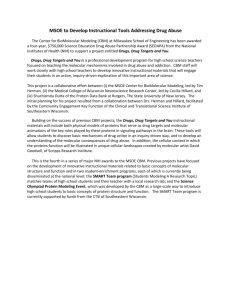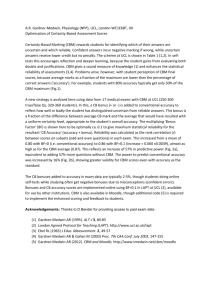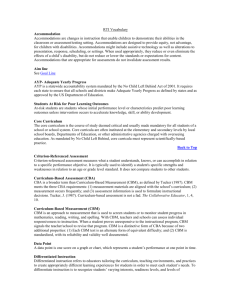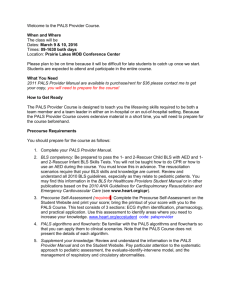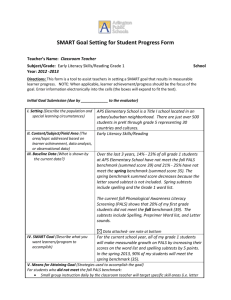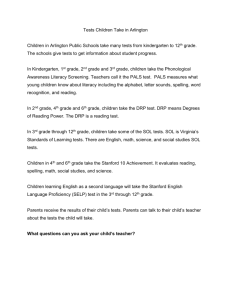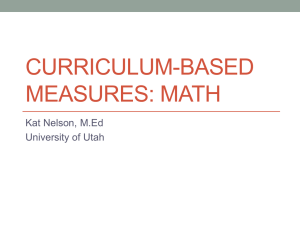Classroom Assessment: Progress Monitoring & Reading Strategies
advertisement
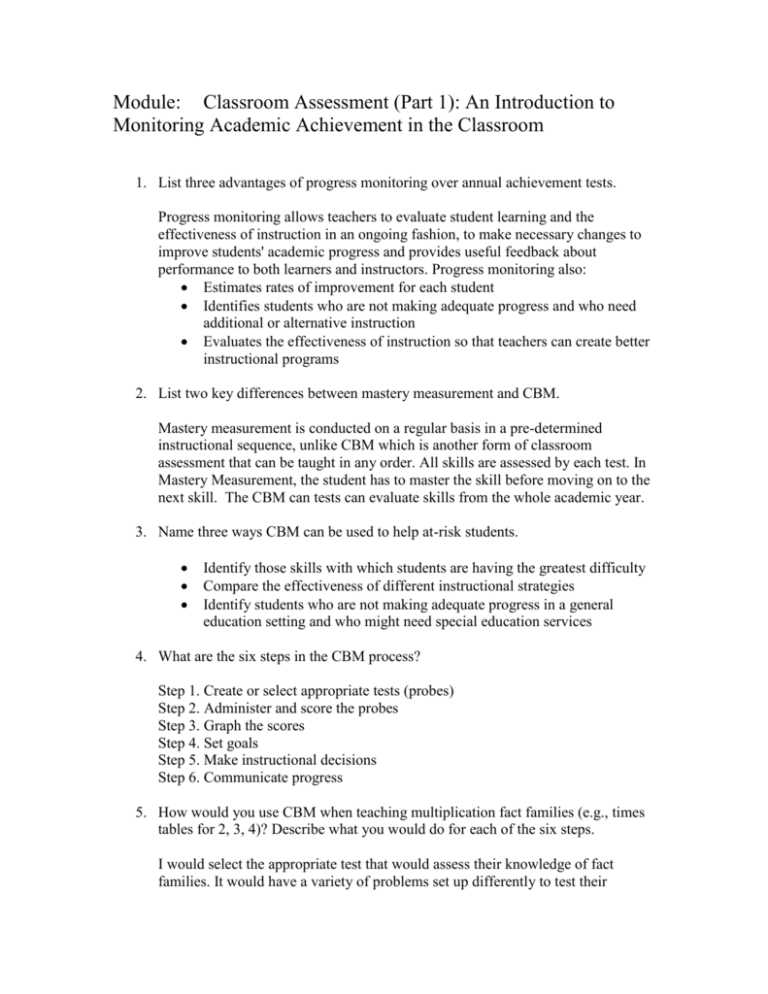
Module: Classroom Assessment (Part 1): An Introduction to Monitoring Academic Achievement in the Classroom 1. List three advantages of progress monitoring over annual achievement tests. Progress monitoring allows teachers to evaluate student learning and the effectiveness of instruction in an ongoing fashion, to make necessary changes to improve students' academic progress and provides useful feedback about performance to both learners and instructors. Progress monitoring also: Estimates rates of improvement for each student Identifies students who are not making adequate progress and who need additional or alternative instruction Evaluates the effectiveness of instruction so that teachers can create better instructional programs 2. List two key differences between mastery measurement and CBM. Mastery measurement is conducted on a regular basis in a pre-determined instructional sequence, unlike CBM which is another form of classroom assessment that can be taught in any order. All skills are assessed by each test. In Mastery Measurement, the student has to master the skill before moving on to the next skill. The CBM can tests can evaluate skills from the whole academic year. 3. Name three ways CBM can be used to help at-risk students. Identify those skills with which students are having the greatest difficulty Compare the effectiveness of different instructional strategies Identify students who are not making adequate progress in a general education setting and who might need special education services 4. What are the six steps in the CBM process? Step 1. Create or select appropriate tests (probes) Step 2. Administer and score the probes Step 3. Graph the scores Step 4. Set goals Step 5. Make instructional decisions Step 6. Communicate progress 5. How would you use CBM when teaching multiplication fact families (e.g., times tables for 2, 3, 4)? Describe what you would do for each of the six steps. I would select the appropriate test that would assess their knowledge of fact families. It would have a variety of problems set up differently to test their knowledge of factoring. I would test the students weekly to assess their improvement of fact families to see what areas are strong, and which areas I should re-teach. I will administer and score the tests in the same way every time. I will graph the scores for each student to see their improvement rate. I will create goals for the class on a percentage of problems they should know by the end of the year. The weekly goals could be to increase their score by a number of points on each probe (e.g. 2 points). After a few weeks of probes, I would determine if the students are improving enough with my instructional strategies or if I should consider adjusting my plan. I will communicate the progress of my students frequently (at least monthly) to the parents and the students. At the end of the semester and year, I can provide improvement awards and encouragement for further successes. 6. Create a CBM implementation plan for your classroom. Make sure you include the academic subject, frequency of administration, how you will score and graph the data, and how you will use the information for your instructional planning. I will make a CBM implementation plan for learning about color theory. I will start by giving the students a test to find out what they already know on everything I want them to learn about color theory in that time. I will make sure that it the material is appropriate for middle school age students. After finding a test I like on the Internet, I have the students take that test for the first time. I save their scores. Then I start teaching the material on the test. Once I have covered all the categories about color in emotion, types of colors, mixing colors, etc., I will test the students again. I will put that score into Power school as well and graph their results. It would be nice to graph results of the class as well based on sections of the tests so I can see what areas need to be concentrated on. I will then determine what to re-teach quickly, and what areas need more time, examples and practice in. After teaching the materials, I will administer another test formally to see their progression. Any students who are far behind the others I will require to study outside of class, and retake the tests on their own outside of class to hopefully improve faster with more effort. My goals to set for the students will be to improve on the test by 10% each time they take it and by the end of art class with me, have a 90% success rate in the color theory questions. By posting their scores online and them also seeing their scores instantly from the selected test site, they will know their progress. I can also send emails to parents indicating who needs further help at home. I can create flash cards or find other helpful web sites or materials to help them reach their goals. Module: PALS: A Reading Strategy for High School Assessment 1. List five benefits of PALS. Describe a classroom situation that might prompt a high-school teacher to implement the strategy. PALS is Is easily implemented Is cost-effective Accelerates student achievement in reading Encourages on-task behavior and student participation Allows students more opportunities to read Allows students to receive corrective feedback Is enjoyable Motivates students Promotes collaboration and positive social interactions 2. Name the three reading activities for PALS for high-school students and describe the reading skills targeted by each. Partner Reading with Retell Reading skills targeted: • Reading fluency • Summarizing Paragraph Shrinking Reading skills targeted: • Identifying the main character • Identifying main ideas • Summarizing Prediction Relay Reading skills targeted: • Making predictions • Identifying main ideas • Summarizing 3. Describe a typical PALS session. Be sure to discuss the roles of both the students and the teacher. I will now summarize how the Partner Reading with Retell PALS session works. First, the higher-performing student starts reading for 5 minutes the selected text that must be appropriate for the lower-performing student. Then, the lowerperforming student starts where the first student left off and reads for 5 minutes as well. Finally the higher-performing student summarizes the main ideas that occur in the story for two minutes. 4. Imagine that you are Ms. McAvoy, a tenth-grade teacher implementing PALS with a class of 29 students. You wish to limit the classroom disruption that occurs when students move to their partners. Select one of the two methods discussed in this module for moving students into pairs for PALS. Explain why you chose this option. I would create a new seating chart that that already has the partners seated by each other. They will have less disruptive time moving around talking to unnecessary students. Seating charts get changed every few weeks anyway, so this would work best for me because I hate wasted time. 5. Again, imagine that you are Ms. McAvoy. Of your 29 students, three are absent, leaving three students without their regular partners. How would you ensure that each student could participate in your regularly scheduled PALS session? If the 2 of the 3 students are higher-performing readers, than they can all work well together giving the third reader the time they need to practice. If two or three students are lower-performing students, than I would rearrange some other groups to accommodate them.
